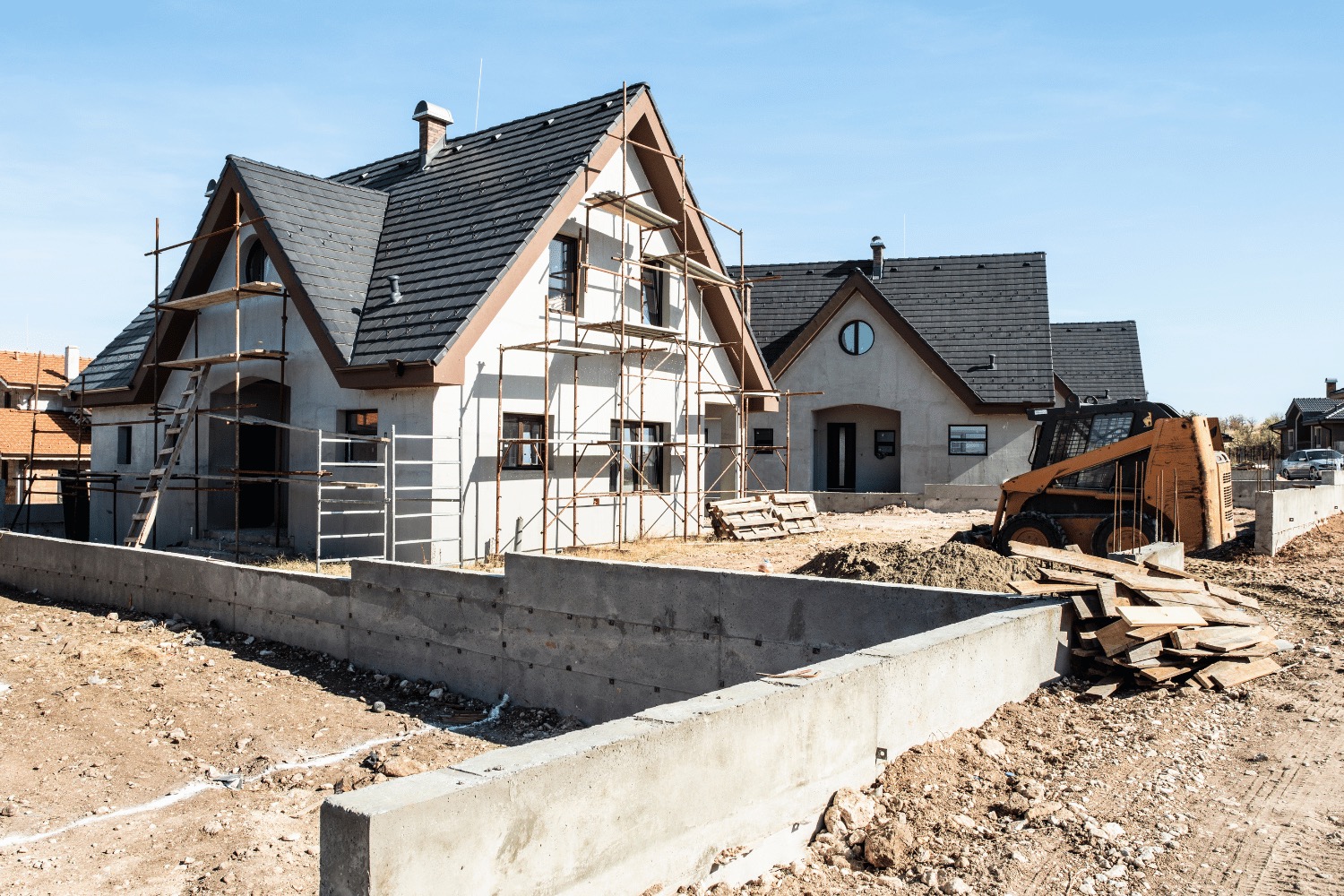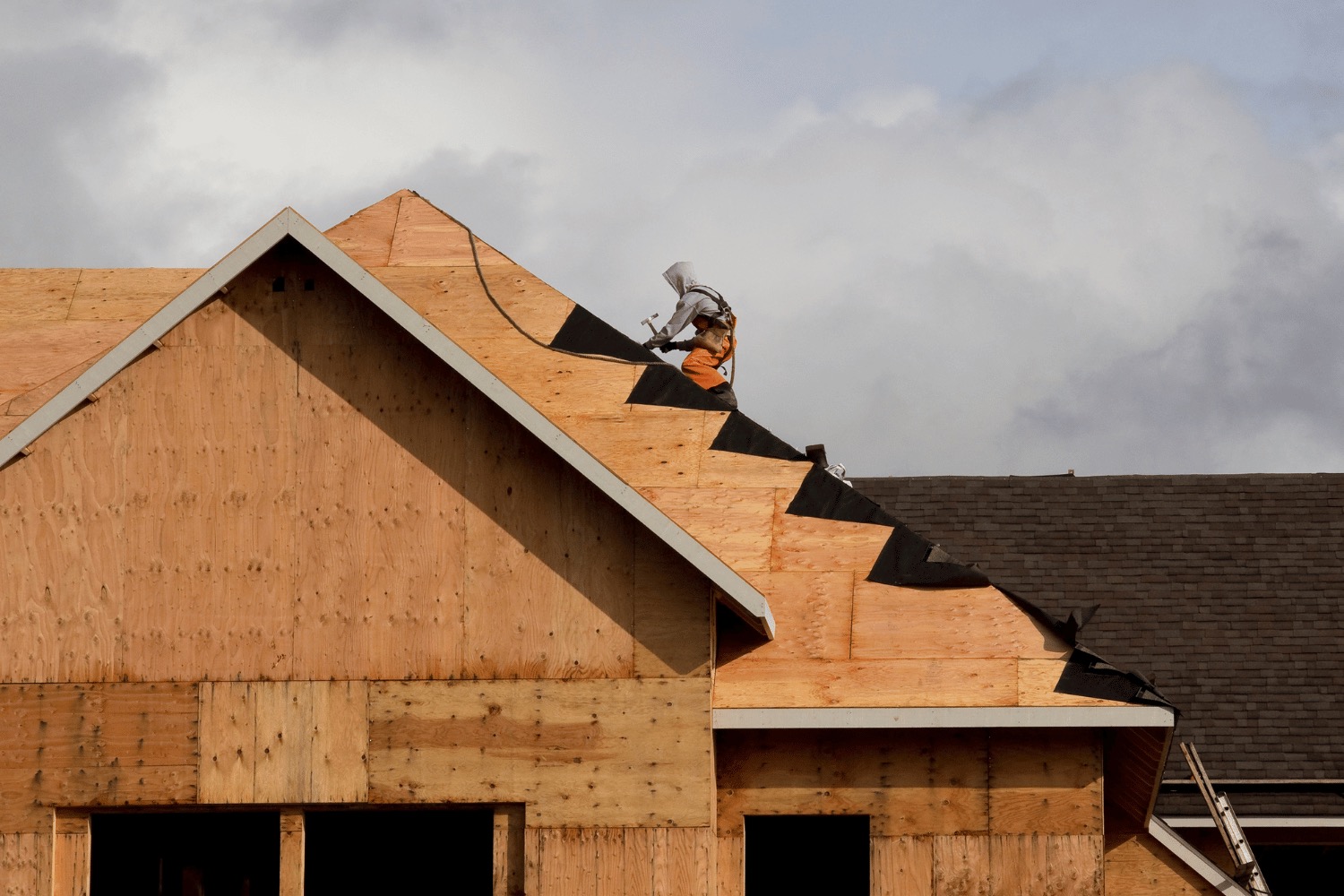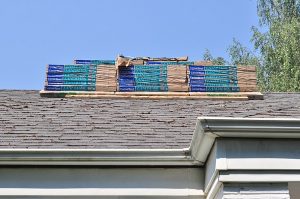Top Tips for Roofing for New Construction Projects
Looking to understand roofing for new construction? This article provides a comprehensive overview of the process, key considerations, material choices, and potential challenges. Whether you’re building a home or a commercial property, learn how to ensure your new roof is both durable and compliant with building codes.
Key Takeaways
-
New construction roofing is a distinct process that integrates seamlessly with the initial building design, requiring precise coordination to avoid delays and additional costs.
-
Key considerations for new construction roofing projects include selecting appropriate materials based on local climate, rigorous budget planning, adherence to safety standards, and compliance with local regulations.
-
Hiring professional roofing contractors ensures proper installation, safety, and adherence to industry standards, ultimately resulting in a high-quality, long-lasting roof.
Understanding New Construction Roofing

New construction roofing refers to the installation of roofing materials on new buildings, a process distinct from roof replacement. Unlike roof replacement, which involves tearing off existing materials from an old roof, new construction roofing adds layers to brand-new structures, working hand-in-hand with ongoing construction projects. This difference determines the methods and timing within the construction timeline.
Roof replacement involves removing old materials, whereas new construction roofing integrates seamlessly into the initial building design. This phase typically occurs simultaneously with other construction activities, requiring precise coordination to ensure everything aligns perfectly. Misunderstanding this process can cause delays and increased costs, highlighting the importance of grasping the unique aspects of new construction roofing.
Recognizing these differences aids in appreciating the unique needs and challenges of new construction roofing projects. The goal is not just to install a roof but to do so in a way that complements the building’s overall design and structural integrity. This approach ensures a long-lasting, aesthetically pleasing, and functional roof that stands the test of time.
Key Considerations for New Construction Roofing Projects
When embarking on a new construction roofing project, several key considerations come into play. One of the foremost is the selection of roofing materials, which should be tailored to the local climate conditions. Choosing the right roofing materials enhances the longevity, maintenance needs, and visual appeal of the building. For instance, an asphalt shingle roof might be ideal for residential properties, while flat roofing materials could be more suitable for commercial buildings.
Budget planning is another critical aspect. Financial readiness involves considering both upfront costs and long-term maintenance, as well as potential future expansions. Safety measures, such as fall protection and weather planning, safeguard workers and prevent accidents during roof installation. Compliance with local building codes and regulations ensures the project’s legality and structural integrity.
Moreover, future-proofing your roof design can accommodate potential expansions and the integration of new technologies. Energy-efficient roofing options, for example, can help reduce indoor temperatures and lower utility costs. Proper roof ventilation and effective drainage prevent moisture buildup and water damage, while also enhancing energy efficiency.
Considering these factors ensures a well-rounded and successful new construction roofing project.
Challenges in New Construction Roofing
New construction roofing projects come with their own set of challenges, distinct from those encountered in roof replacement projects. Safety is a paramount concern, given the hazardous working conditions involved. Hiring professional roofing contractors who follow safety standards and practices mitigates these risks.
Next, we will delve into the specific challenges faced in residential and commercial roofing projects.
Residential Roofing Challenges
Residential new construction roofing often involves dealing with various framing issues. Common problems include improperly angled Bird’s Mouth cuts, imprecise rafter lengths, unsupported roof sheathing, and drainage issues. For instance, imprecise rafter lengths can lead to rafters not seating properly on supporting members, compromising the roof’s stability. Effective communication with contractors ensures the roof framing is ready for installation and helps identify potential framing problems early.
Another critical aspect is the installation of roof crickets to prevent standing water, which can lead to significant roof damage over time. Proper drainage is essential to maintain the roof’s longevity.
Additionally, homeowners must consider the various residential roofing styles, such as Dutch gable, dormer, intersecting/overlaid hip, and hip and valley, to match their aesthetic preferences and functional needs.
Commercial Roofing Challenges
Commercial roofing projects present their own unique set of challenges, particularly in addressing drainage and structural considerations. Proper drainage is essential to prevent water pooling, which can lead to leaks and structural damage. Effective drainage systems are crucial for the roof’s longevity and safety. Additionally, the structural requirements must consider load-bearing capacities and comply with local building codes to ensure safety and compliance.
Early involvement of roofing professionals is recommended once the roof is sheeted to address any specific challenges effectively. This proactive approach identifies and mitigates potential issues early, ensuring a smooth and efficient roofing process for commercial buildings.
The New Construction Roofing Process

The new construction roofing process involves several critical steps, from initial planning and design to installation and final inspection. Each phase requires attention to detail and coordination with other construction crews to seamlessly integrate the construction roof into the overall building structure.
Let’s explore these phases in more detail.
Initial Planning and Design
The initial planning and design phase of a new construction roofing project is crucial for its success. This phase requires in-depth planning to ensure compatibility with the building’s design. Architectural considerations play a significant role in selecting suitable roofing materials, as they must align with the overall aesthetic and structural requirements of the building. Choosing roofing materials ahead of time can prevent delays related to stock availability, ensuring a smooth workflow.
Additionally, a thorough inspection of the building envelope is necessary to inform roofing decisions and identify any potential issues that need to be addressed before proceeding. Roofing work should start only after the contract is approved and signed, ensuring all parties agree on the project’s scope and expectations.
Installation Phase
During the installation phase, adequate time should be allocated to avoid rushing the project and compromising quality. Coordination with other construction crews is vital to maintain workflow and ensure that roofing tasks do not interfere with other ongoing activities. For example, Waddle Exteriors Roofing has dedicated commercial and residential roofing crews to ensure effective collaboration and timely completion of roofing projects.
Roofing work can begin upon contract approval, with professionals working quickly and safely without interrupting other on-site crews. Selecting roofing materials early can help avoid delays and ensure a smooth installation phase.
Final Inspection and Quality Assurance
The final inspection and quality assurance phase is crucial in ensuring that the roofing project meets all required standards and specifications. This process involves a comprehensive walkthrough to identify installation issues and verify that all roofing requirements have been met. Post-installation inspections ensure proper work execution, providing assurance of quality and peace of mind for the property owner.
Waddle Exteriors conducts thorough inspections post-completion to ensure that all aspects of the roofing project have been properly executed. Final inspections guarantee correct installation and high-quality standards, ensuring a long-lasting and reliable roof.
Choosing the Right Roofing Materials for New Construction

Choosing the right roofing materials for new construction impacts the roof’s durability, maintenance needs, and aesthetic appeal. Various roofing materials are available, including metal, flat, asphalt, and wood roofing, each with its own set of advantages and disadvantages. Residential or steep-slope roofing often features several common options. These include asphalt shingles, stone-coated metal shingles, standing seam metal, metal panels, and tile.
When budgeting for roofing materials, it’s important to consider both initial installation roof cost and potential long-term maintenance expenses. Balancing upfront costs with long-term savings helps you make an informed decision that provides the best value for your investment. For example, metal roofs can last up to 50 years, offering significant long-term savings despite higher initial costs.
Additionally, the aesthetic value of a roof should align with the architectural style of the home and personal preferences. Whether you prefer the classic look of wood shingles or the modern appeal of metal roofing, the right choice can enhance the overall curb appeal of your property.
Carefully evaluating options and considering durability, cost, and aesthetics helps you select the best roofing material for your new construction project.
Benefits of Hiring Professional Roofing Contractors

Hiring professional roofing contractors for your new construction project offers numerous benefits, ensuring a successful and stress-free experience. Experienced professionals from a roofing company bring expertise and knowledge to the table, ensuring proper installation and adherence to industry standards. This expertise helps identify and resolve roofing issues quickly, preventing minor problems from escalating into major ones.
Hiring a professional contractor ensures the work will be done correctly and safely, providing peace of mind. Professionals use specialized tools and safety materials, minimizing risks during installations. Hiring professionals also saves time, as they efficiently complete tasks without the delays of DIY efforts.
Reputable contractors also provide warranties on both materials and workmanship, protecting homeowners in case of issues. They maintain relationships with suppliers, allowing them to source materials cost-effectively and pass savings onto clients. Hiring professional roofing contractors ensures a high-quality, durable, and aesthetically pleasing roof for your new construction project, as well as reliable roof repairs.
Waddle Exteriors’ Approach to New Construction Roofing

Waddle Exteriors has been a trusted name in the roofing industry since 1978, offering over 40 years of experience in roof consultations. As a multifaceted exterior solutions provider, Waddle Exteriors offers a comprehensive range of services, including residential roofing, roof inspection, and roof restoration. Their collaboration with GAF, a leading manufacturer of roofing materials, ensures high-quality products for every project.
Waddle Exteriors’ commitment to quality and service is reflected in their customer satisfaction rating of 4.9 based on 465 reviews. Customers report having a seamless and smooth experience, particularly appreciating their communication and quality workmanship. Waddle Exteriors provides support throughout the roofing process, including guidance in finding optimal financing choices tailored to roofing projects.
Their approach to roofing involves meticulous planning, expert installation, and thorough post-installation inspections. Choosing Waddle Exteriors ensures top-notch roofing services that meet the highest standards of quality and durability.
Summary
In summary, new construction roofing is a complex but essential aspect of building a new home or commercial property. By understanding the process, considering key factors, addressing challenges, and selecting the right materials, you can ensure a successful roofing project. Hiring professional roofing contractors like Waddle Exteriors offers numerous benefits, from expert installation to quality assurance. With over 40 years of experience and a commitment to excellence, Waddle Exteriors is your trusted partner for all your roofing needs.
Frequently Asked Questions
What makes new construction roofing different from roof replacement?
New construction roofing differs from roof replacement as it entails the installation of roofing materials on newly built structures, whereas roof replacement requires the removal and replacement of existing roofing materials on older buildings.
Why is selecting the right roofing material important?
Selecting the right roofing material is crucial as it influences the roof’s durability, maintenance requirements, and aesthetic value, tailored to the local climate and architectural design. A well-chosen roofing material ensures long-term performance and satisfaction.
What are some common residential roofing challenges?
Common residential roofing challenges include framing issues, improper drainage, and the necessity for effective communication with contractors to guarantee correct installation. Addressing these challenges is essential for ensuring the longevity and integrity of your roof.
How does Waddle Exteriors ensure quality in their roofing projects?
Waddle Exteriors ensures quality in their roofing projects by conducting thorough post-installation inspections, which confirm the proper execution of their work. This commitment to quality provides clients with peace of mind regarding the durability and reliability of their roofs.
What benefits do professional roofing contractors offer?
Professional roofing contractors provide expertise, ensuring quality workmanship and safety, while also saving you time and offering warranties on both materials and labor. Their access to cost-effective sourcing of materials further enhances the value of their service.




